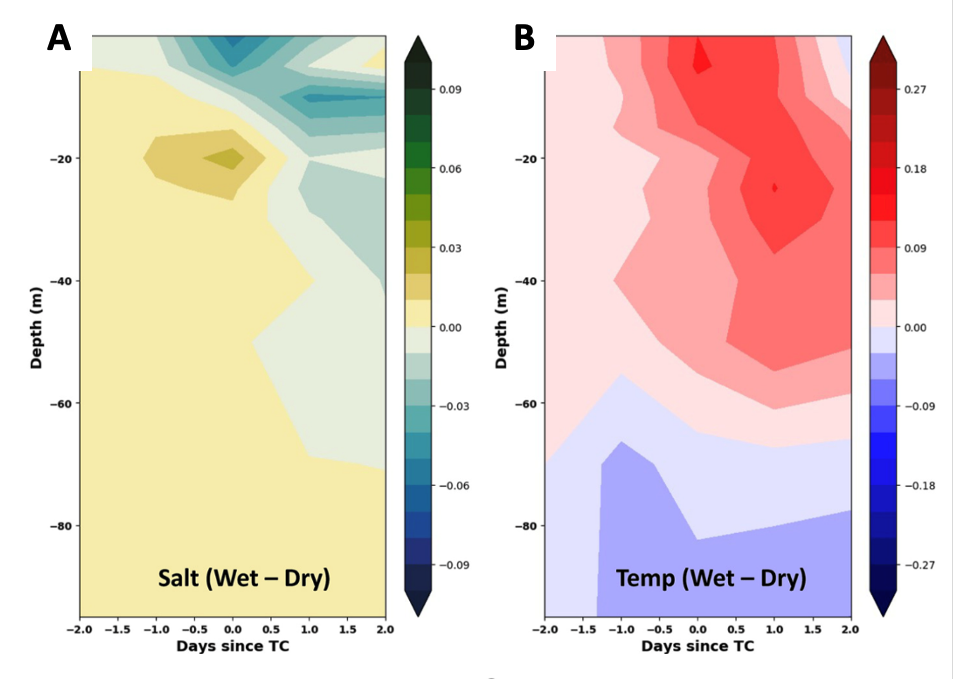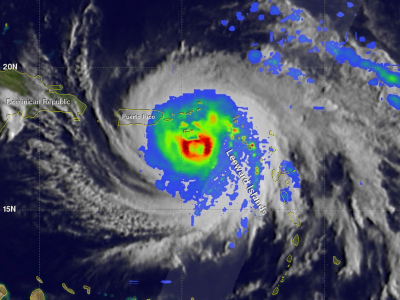Rainfall Decreases Tropical Cyclone-Induced Sea Surface Cooling
Tropical cyclones induce sea surface cooling, but heavy rainfall reduces the effect through increased ocean mixing.
The Science
Strong winds associated with tropical cyclones (TCs) induce significant mixing at the ocean surface. This process brings cooler sub-surface water up to the surface mixed layer, resulting in sea surface cooling and changes in salinity stratification. Researchers used a combination of observations and high-resolution numerical model simulations to demonstrate that when TCs produce high amounts of rain, and the added freshwater can form stratified layers in the upper ocean, these layers limit mixing between the warm water at the surface and the cooler water that lies below. This weakened mixing reduces the storm-induced sea surface cooling, potentially promoting storm intensification.
The Impact
TCs intensify by extracting heat energy from the ocean surface, making the sea surface temperature under storms critical for their development. The results of this study have several important implications. Firstly, a mechanism not represented in uncoupled stand-alone atmospheric models was identified, which may lead to the misrepresentation of TC intensification. Second, the study calls for an improved and accurate representation of salinity processes in the fully-coupled models used to understand and predict TC intensification. Finally, as the hydrological cycle is projected to strengthen under global warming, the rainfall-induced positive feedback mechanism for TC intensification may amplify and become more important in the future.

Figure 1. Difference in the composite mean anomalous upper-ocean A) salinity (psu) and B) temperature (deg C) response between ‘Wet’ and ‘Dry’ TCs based on 20 years of high-resolution E3SM simulations. Relative to ‘Dry’ TCs, the upper ocean freshens considerably and cools less for ‘Wet’ TCs due to the increase in salinity stratification. ‘Anomalous’ refers to deviation from the pre-storm state and ‘composite mean’ indicates averaging across all wet/dry cases.
Summary
Using observations and numerical model simulations, a research team systematically demonstrated that rainfall associated with TCs reduces the sea surface cooling induced by them (Fig. 1). First, researchers used satellite and ocean reanalysis products to perform an along-track Lagrangian composite analysis to follow TCs in space and time. Specifically, they computed the initial storm state, rain rates, pre-storm ocean initial state, and the change in sea surface salinity and temperature along TC tracks. Next, the researchers demonstrated that storms with more rain (above the 90th percentile) freshened the ocean by about 0.1 psu (practical salinity unit), and experienced cold wakes weaker by about 0.25oC than storms that rain less (rain rate below the 10th percentile). To support these observational results, they analyzed 20 years of output from the high-resolution Energy Exascale Earth System Model (E3SM). They performed a similar Lagrangian composite analysis and found that the simulation results are broadly consistent with those from observations. The team used E3SM to show that mixing processes in the ocean are primarily responsible for the rainfall effect on sea surface cooling, with surface fluxes playing a weaker role. Finally, they used the Price-Weller-Pinkel ocean mixed layer model to conduct idealized sensitivity experiments to further understand the role of mixing. The results of the simulations agreed well with those obtained from observations and E3SM.
Publication
- Balaguru, Karthik, Gregory R. Foltz, L. Ruby Leung, and Samson M. Hagos. 2022. “Impact Of Rainfall On Tropical Cyclone‐Induced Sea Surface Cooling”. Geophysical Research Letters 49 (10). American Geophysical Union (AGU). doi:10.1029/2022gl098187.
Funding
- This work was supported by the Regional and Global Model Analysis program area of the Department of Energy, Office of Science, Biological and Environmental Research program.
Contact
- L. Ruby Leung, Pacific Northwest National Laboratory
This article is a part of the E3SM “Floating Points” Newsletter, to read the full Newsletter check:



